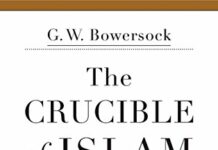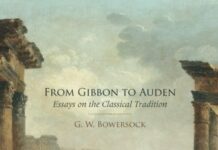
Ebook Info
- Published: 2008
- Number of pages: 180 pages
- Format: PDF
- File Size: 14.17 MB
- Authors: G. W. Bowersock
Description
Using pagan fiction produced in Greek and Latin during the early Christian era, G. W. Bowersock investigates the complex relationship between “historical” and “fictional” truths. This relationship preoccupied writers of the second century, a time when apparent fictions about both past and present were proliferating at an astonishing rate and history was being invented all over again. With force and eloquence, Bowersock illuminates social attitudes of this period and persuasively argues that its fiction was influenced by the emerging Christian Gospel narratives.Enthralling in its breadth and enhanced by two erudite appendices, this is a book that will be warmly welcomed by historians and interpreters of literature.
User’s Reviews
Editorial Reviews: Review “The fascination and importance of this book arises above all from its own purpose, but its dazzling insights have special value as well to the world in which controversy rages over rewritings of history. . . . Fiction as history is a timely and, as this wonderful book makes clear, timeless topic.” — Thomas R. Martin, History Book Club Review”[Bowersock] uses pagan prose fiction produced in Greek and Latin during the early Christian era to investigate the complex relations between ‘historical’ and ‘fictional’ truths. . . and concludes that even in late antiquity the great novelists appealed to Christians as much as to pagans.” — New Testament Abstracts About the Author G. W. Bowersock is Professor of Ancient History at the Institute for Advanced Study in Princeton. Among his many books are Roman Arabia (1983) and Hellenism in Late Antiquity (1990). He is coeditor of A. D. Momigliano: Studies on Modern Scholarship (California 1994).
Reviews from Amazon users which were colected at the time this book was published on the website:
⭐This magnificent essay on fiction writing in the middle and late Empire really deserves five stars, except for the intellectual cowardice that makes G.W.Bowersock leave the obvious results of his research unsaid. And yet the book is packed full of thought, its tiny dimension – barely 150 thinly-printed pages – being entirely misleading in terms of its immense learning and insight. Bowersock examines the rise of an entirely new kind of fiction – self-consciously fictive prose, from the great Hellenistic novels to the sarcastic dialogues of Lucian – in the middle Roman Empire, beginning with the fragmentary SATYRICON of Petronius Arbiter. (One blatant omission is Seneca’s PUMPKINIFICATION OF CLAUDIUS, strangely out of keeping with the author’s vast frame of reference; yet some of the conclusions that could be drawn from this unchivalrous piece of speaking ill of the dead would fit very well with Bowersock’s own views.) Moving back and forth across three centuries, with swift yet elegant dashes to huge areas beyond (e.g. a brief but fascinating excursus about Lessing’s attitude to Philoktetes), Bowersock builds a brilliant argument that all this prose fiction was closely influenced, possibly even roused by, the New Testament and succeeding Christian writing. His analysis of the terrible “cannibalism” passage in the SATYRICON is especially illuminating, and proves, in my view, beyond the shadow of a doubt, that the notion of transubstantiation and the eating of the Body of Christ in bread was already known, in exactly the historical terms of the Church, in 64AD. Bowersock, in effect, reverses one of the commonplaces of modern NT criticism: where the modern NT critic sees the Hellenistic Roman prose writing as affecting the rising Christian religion, Bowesock shows that it was itself affected by it – in some cases, pretty blatantly, so that one wonders how NT exegetes could possibly miss the fact that the authors of this or that romance were imitating rather than being imitated.This being such a fine piece of work, why do I only award it four stars instead of five? Because Bowersock is plainly terrified of his own results. He does not want to say out loud that a generation that lived in the reign of Nero (i.e. within living memory of Christ) had a clear understanding of Transubstantiation; he does not want to say out loud that, far from being obscure and unknown, Christianity was a major cultural leaven from a very early period; above all, he would sew his own lips shut rather than admit that every piece of his excellent analysis goes to reinforce the notion of a historical Jesus within the terms and parameters of the Gospels. Professor Bowersock is – unfortunately for him – a widely respected figure in the academic establishment. He certainly would lose caste among his scholarly colleagues if he were more explicit about what he has to say; however, he must at least be complimented on having done nothing to disguise or conceal, as more than one other academic has done, the tendency of his results.
⭐With all due respect to the other reviewer’s enthusiasm, the Eucharist was of course already known by 60 a.d, since Paul clearly refers to it in 1 Cor. 11:23-25, written before 58 a.d., as were all of his authentic letters. We don’t need Satyricon as proof of that, but we do need to note that Petronius is mocking the familiar mystery religion ritual dogma of eating the god, e.g. Dionysius, not necessarily the Christian sacrament. He elsewhere in the fragments that survive, mocks the notion of resurrection, with reference to Protesilaus and Mercury, i.e. Hermes psychopomp of Hades. Since internal evidence alone, shows that none of the Gospels could have been written before 68 a.d., it remains unclear to me what Bowersock has to be terrified of; unless it is the Shadow of orthodoxy itself. He certainly shows that resurrection tales were a popular theme in contemporary Latin literature, some of it indeed post-dating the Christian sources and some of it earlier. The genre itself can be traced back to the Greek world of Herodotus and further to the Sumerian legend of Inanna, i.e. Ishtar. So what is there to be afraid of here?…
⭐
Keywords
Free Download Fiction as History: Nero to Julian in PDF format
Fiction as History: Nero to Julian PDF Free Download
Download Fiction as History: Nero to Julian 2008 PDF Free
Fiction as History: Nero to Julian 2008 PDF Free Download
Download Fiction as History: Nero to Julian PDF
Free Download Ebook Fiction as History: Nero to Julian





